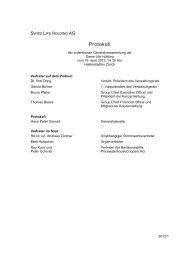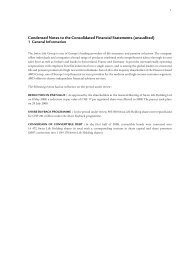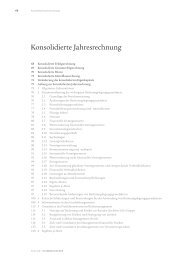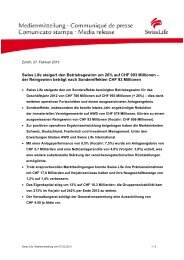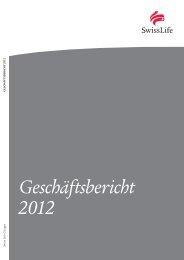Annual Report 2012 - Swiss Life
Annual Report 2012 - Swiss Life
Annual Report 2012 - Swiss Life
Create successful ePaper yourself
Turn your PDF publications into a flip-book with our unique Google optimized e-Paper software.
151 Consolidated Financial Statements<br />
To reduce the credit exposure relating to derivatives a collateral management process has been established.<br />
Contractually all outstanding positions must be fully collateralised if they reach a very low<br />
agreed minimum transfer amount. The collateral is called at least weekly, but in times of turbulent<br />
markets the frequency is increased. As leverage is not permitted, certain coverage rules apply with<br />
regard to cash or long positions. Counterparties for derivative transactions, over-the-counter and<br />
exchange-traded, have to be approved by both the Group Chief Risk Officer and the Group Chief<br />
Investment Officer. The minimum rating for a counterparty is A– (Standard & Poor’s or equivalent)<br />
for the <strong>Swiss</strong> <strong>Life</strong> Group’s insurance operations. During periods of market turmoil reliance on ratings<br />
is of limited value; therefore an additional qualitative and quantitative counterparty monitoring<br />
process has been established to allow for immediate proactive measures.<br />
Counterparty risk is managed through the holding of credit default swaps or credit default swap<br />
indices. A credit default swap provides insurance to the debt holder against a default of the debt<br />
issuer. It is traded over-the-counter and itself underlies the collateral management process described<br />
above. The credit default swap index is a hedge on credit risk of a basket of counterparties and is an<br />
exchange-traded derivative.<br />
The Group is also exposed to credit risk associated with reinsurance recoverables. As a consequence,<br />
the financial strength of reinsurers is monitored. The creditworthiness of reinsurers is considered on<br />
an annual basis by reviewing their financial strength and also prior to any contract being signed. The<br />
general policy of the <strong>Swiss</strong> <strong>Life</strong> Group is to reinsure its insurance risks only with counterparties rated<br />
A– or above (Standard & Poor’s or equivalent). In exceptional cases, reinsurers with a lower rating may<br />
be considered. Additionally, the Group holds substantial collateral under related reinsurance agreements<br />
in the form of deposited funds and securities.<br />
No single reinsurer is a material reinsurer to the Group, nor is the Group’s business substantially<br />
dependent upon one single reinsurer.<br />
For fixed-income assets the total exposure per counterparty is aggregated and reported to the Group<br />
Risk Committee. The individual operations maintain records of the payment history for the significant<br />
contract holders with whom they conduct regular business. Ratings and single positions above a certain<br />
level with regard to fixed-income assets are reported to management on a regular basis. The exposure<br />
to individual counterparties is also managed by other mechanisms such as the right to offset where<br />
counterparties are both debtors and creditors of the Group. In addition, limits regarding single counterparty<br />
exposure are in place which depend on the rating and amount of exposure in relation to total<br />
investments. Information reported to management includes assessment of bad debts. Where there<br />
exists a certain exposure to individual policyholders, or homogenous groups of policyholders, a financial<br />
analysis equivalent to that conducted for reinsurers is carried out.<br />
The non-rated loans primarily comprise mortgages and policy loans. For the bulk of the mortgages a<br />
risk class system is in place which allows the company to identify, measure, monitor and manage the<br />
risks at the level of portfolios, borrowers and loans at all times. The risk class system also enables a<br />
risk-adequate pricing of the loans. Implementation, parametrisation and control of the system are set<br />
out in an internal directive which has been approved by the Group Chief Investment Officer.<br />
In certain countries, specific additional guidelines and rules have been defined locally to monitor<br />
credit risk. Such guidelines cover investments in fixed-income securities which are mostly based on<br />
the average rating of the issuers (calculated by weighting default probabilities). Minimum and maxi-<br />
<strong>Swiss</strong> <strong>Life</strong> – <strong>Annual</strong> <strong>Report</strong> <strong>2012</strong>



